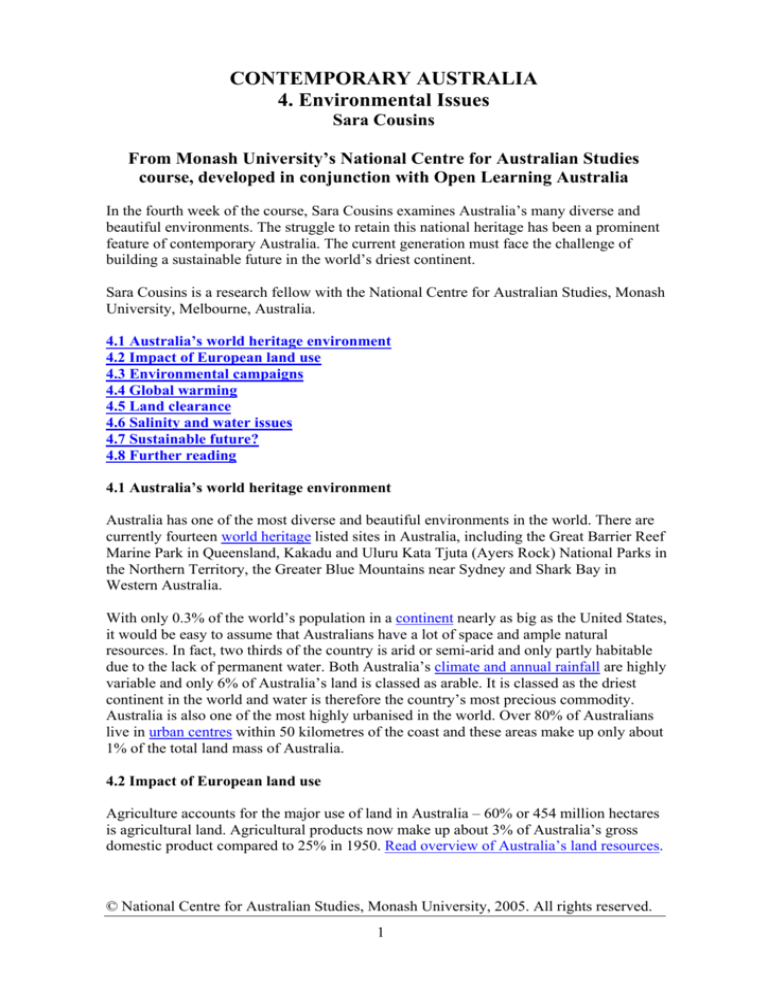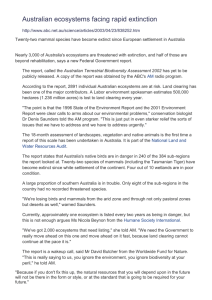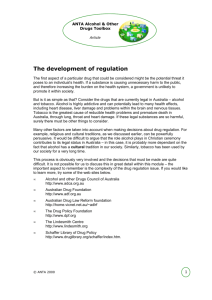
CONTEMPORARY AUSTRALIA
4. Environmental Issues
Sara Cousins
From Monash University’s National Centre for Australian Studies
course, developed in conjunction with Open Learning Australia
In the fourth week of the course, Sara Cousins examines Australia’s many diverse and
beautiful environments. The struggle to retain this national heritage has been a prominent
feature of contemporary Australia. The current generation must face the challenge of
building a sustainable future in the world’s driest continent.
Sara Cousins is a research fellow with the National Centre for Australian Studies, Monash
University, Melbourne, Australia.
4.1 Australia’s world heritage environment
4.2 Impact of European land use
4.3 Environmental campaigns
4.4 Global warming
4.5 Land clearance
4.6 Salinity and water issues
4.7 Sustainable future?
4.8 Further reading
4.1 Australia’s world heritage environment
Australia has one of the most diverse and beautiful environments in the world. There are
currently fourteen world heritage listed sites in Australia, including the Great Barrier Reef
Marine Park in Queensland, Kakadu and Uluru Kata Tjuta (Ayers Rock) National Parks in
the Northern Territory, the Greater Blue Mountains near Sydney and Shark Bay in
Western Australia.
With only 0.3% of the world’s population in a continent nearly as big as the United States,
it would be easy to assume that Australians have a lot of space and ample natural
resources. In fact, two thirds of the country is arid or semi-arid and only partly habitable
due to the lack of permanent water. Both Australia’s climate and annual rainfall are highly
variable and only 6% of Australia’s land is classed as arable. It is classed as the driest
continent in the world and water is therefore the country’s most precious commodity.
Australia is also one of the most highly urbanised in the world. Over 80% of Australians
live in urban centres within 50 kilometres of the coast and these areas make up only about
1% of the total land mass of Australia.
4.2 Impact of European land use
Agriculture accounts for the major use of land in Australia – 60% or 454 million hectares
is agricultural land. Agricultural products now make up about 3% of Australia’s gross
domestic product compared to 25% in 1950. Read overview of Australia’s land resources.
© National Centre for Australian Studies, Monash University, 2005. All rights reserved.
1
Over time, other industries such as manufacturing, mining and services have expanded
significantly. However much of the damage to the environment from land clearing,
desertification, salination, water degradation and soil acidity has already been done.
Methods of agriculture imported from Europe by the first migrants to Australia were
highly unsuitable for the climate, particularly the limited rainfall, and soils. Australia, a
continent millions of years old, has soils that are ancient, fragile and beset by accumulated
salts. Land clearing - one third of native forests have already gone to make way for
agriculture, mining and forestry - has resulted in a huge loss of biodiversity and severe soil
erosion. Read more…
4.3 Environmental campaigns
Far from being merely an historical issue, many would argue that today, with the benefit of
highly sophisticated scientific data and technology at its disposal, the government is still
not committing the financial resources that are needed to combat the extent of the problem.
Over the past thirty years, environmental campaigns have expanded, strengthened and in
some cases managed to halt development threatening serious degradation to the natural
environment. A turning point in the history of such environmental activism occurred in the
early 1980s concerning the Franklin River in Tasmania, where the State Government
planned to build a dam for the production of hydroelectricity. The intense campaign led to
a term of imprisonment for the most prominent activist, Bob Brown, and to a High Court
case that upheld the Commonwealth’s world heritage legislation. Bob Brown subsequently
became leader of The Australian Greens and is currently Senator for Tasmania in Federal
Parliament.
Activists and environmental lobby groups today such as the Australian Conservation
Foundation, Greenpeace, The Wilderness Society and Friends of the Earth Australia, focus
their attention on major issues such as climate change, land clearing, soil and water
degradation, loss of biodiversity and damage to the coastal and marine environment. It is
not only environmentalists who are raising issues of concern regarding Australia’s
environment. Explore Australia’s landscape and biodiversity.
Many farmers, Indigenous landowners, scientists, and industry and community groups are
voicing their views about the need for a sustainable approach to managing Australia’s
precious natural resources. See for example, the policy statements of the National Farmers
Federation, the Indigenous Land Corporation and the Wentworth Group of Concerned
Scientists.
4.4 Global warming
While there is still some debate, scientific research has shown that the earth is gradually
warming with average temperatures in Australia rising 0.8% since the beginning of the
twentieth century. Global warming is largely the result of increases in greenhouse gas
emissions and carbon dioxide concentration and their effect on the earth’s atmosphere. The
impact on Australia, particularly its agricultural industry, could be significant. Australian
farmers have already experienced the combined effects of the El Nino weather pattern,
warmer temperatures, less rainfall, longer droughts and more severe bushfires. Native
forests, wetlands, riverine environments, alpine ecosystems and marine environments are
© National Centre for Australian Studies, Monash University, 2005. All rights reserved.
2
likely to become even more vulnerable. Rising sea-levels and extreme weather may
threaten urban and coastal communities.
Internationally, efforts have been made to combat the effects of climate change through
agreements such as The Kyoto Protocol. This treaty, part of a wider global environmental
governance movement, creates targets by which developed countries will limit their
greenhouse gas emissions. Australia signed the treaty in 1997, making a commitment to
limit emissions growth to 108% of its 1990 level. In 2002 however, the Howard
Government announced that Australia would not ratify the treaty because it excluded
developing countries and the United States. Read Government’s press release.
Debate about whether or not Australia should ratify the Kyoto Protocol continues to
dominate discussion of appropriate global responses to climate change.
4.5 Land clearance
Over a century of land clearing for agriculture has resulted in the significant loss of native
forest and woodlands in Australia. Much of the land clearing has occurred since 1980. The
Federal Government has spent a substantial amount of money and committed resources to
repairing the environment under the National Heritage Trust and the National Landcare
Program. However, according to environmental lobby groups, land clearing has in fact
increased in the past five or so years with most of the damage occurring in Queensland,
New South Wales and Tasmania. Land clearance destroys fragile ecosystems, threatens
biodiversity, and can cause soil degradation leading to salinity and loss of water quality.
Estimates from the Australian Bureau of Statistics indicate that 470 000 hectares of land
were cleared in 1990 and 90% of this land was in Queensland. This is equivalent to over
740 football fields every day. In 1999, 40% more land was cleared than in 1990. Read the
ABS Report: Measuring Australia’s Progress 2002…
4.6 Salinity and water issues
Dryland salinity and water degradation are closely associated with land clearance.
Australia’s soils have been accumulating salts for up to a hundred thousand years, most
probably blown to the landscape from the seas. Prior to European settlement and land
clearing, trees and vegetation soaked up the rainfall keeping the salt at a manageable level.
Over time, with the loss of that vegetation, the amount of water draining into the
groundwater increases and this can then mobilise salts stored in the soil. Salinity affects
agricultural crops, fish, birds and other wildlife relying on wetlands, and rivers that are
vital water supplies. It can also seriously affect urban areas damaging housing
infrastructure, roads, water pipes and railways. Read more…
The National Land and Resources Audit has recently estimated that 17 million hectares in
Australia will be at risk of serious dryland salinity problems by 2050. The southwest
agricultural region of Western Australia is the worst affected, with over 4 million hectares
at risk – a figure that could double by 2050.
Given the severity of the problem, there are major questions being asked about the future
of irrigated farming in Australia and to what extent it is in fact possible to tackle salinity.
Listen to ABC Radio National debate on water on the Australia Forums.
© National Centre for Australian Studies, Monash University, 2005. All rights reserved.
3
4.7 Sustainable future?
The recent Earth Summit 2002 was entirely focused on ways to achieve sustainable future
development. The summit brought together countries from all over the world to consider
issues as varied as HIV/AIDS, food security, climate change, freshwater and sustainable
finance. It also attracted strong demonstrations and walk-outs over what protestors saw as
the lack of commitment amongst some of the world’s wealthiest nations to reduce poverty
and tackle greenhouse gas emissions.
In Australia, government bodies like Land and Water Australia are committed to achieving
sustainable natural resource management. Other research organisations such as the
Institute for Sustainable Futures and the Centre for Indigenous Natural and Cultural
Resource Management are dedicated to working in partnership with industry, government
and community towards an ecologically sustainable future for Australians. Sustainability
also raises concerns about population policy, that is what level of population Australia’s
environment can sustain? Some, including the lobby group Sustainable Population
Australia, argue in favour of stabilising the population for ecological reasons. Other groups
such as the Business Council of Australia urge increased migrant intake to stimulate
economic activity. While the debate continues, some Australians worry that environmental
degradation will rage out of control.
The question for the 21st century remains – will the necessary changes to current and past
practices occur fast enough to save our natural heritage?
4.8 Further reading
Contemporary issues
Latest Environmental Issues
Australian Broadcasting Corporation (ABC), News Online
http://www.abc.net.au/news/environment
Earthbeat
ABC Radio National
http://www.abc.net.au/rn/science/earth
The Environment
Australian Policy Online
http://www.apo.org.au/environment.shtml
Environmental Campaigns
Social Change Online
http://media.socialchange.net.au/environ.html
© National Centre for Australian Studies, Monash University, 2005. All rights reserved.
4
Resources on Environment and Natural Resources
Australian Parliament, Library Internet Guide
http://www.aph.gov.au/library/intguide/sci/scienv.htm
Environmental agencies
Department of Environment and Heritage
Commonwealth Government
http://www.ea.gov.au
Landcare Australia
Commonwealth Government
http://www.landcareaustralia.com.au/
National Heritage Trust
Commonwealth Government
http://www.nht.gov.au/
Murray Darling Basin Commission
Commonwealth Government
http://www.mdbc.gov.au/
Bureau of Meteorology
Commonwealth Government
http://www.bom.gov.au/
World Wide Fund for Nature Australia
Non Government organisations
http://www.wwf.org.au/
Greening Australia
Commonwealth Government partner organisation
http://www.greeningaustralia.org.au
Green Net Australia
Non Government organisation
http://www.green.net.au/
The Kyoto Protocol
The Kyoto Protocol, Issues and Developments through to Conference of the Parties
(COP7), September 2002
Australian Parliament, Library Internet Guide
http://www.aph.gov.au/library/intguide/SCI/kyoto.htm
Submission to Joint Standing Committee on Treaties Inquiry into the Kyoto Protocol,
August 2000, Department of Foreign Affairs and Trade
Commonwealth Government
http://www.dfat.gov.au/environment/climate/jscot_sub.html
© National Centre for Australian Studies, Monash University, 2005. All rights reserved.
5
Population debate
The Australian Population Institute
http://www.apop.com.au
Setting the Limits: Australia’s Population Debate
ABC News Online Forum
http://www2b.abc.net.au/news/forum/forum58/default.htm
Big Ideas, Australia Forums with Michael Cathcart: Population Debate
ABC Radio National
http://www.abc.net.au/rn/bigidea/stories/s596388.htm
Search for ‘Care for the Earth Policy’
Australian Greens
http://www.greens.org.au
Back to top
© National Centre for Australian Studies, Monash University, 2005. All rights reserved.
6









